Where to go in Switzerland on a short trip: Alps, lakes, and cities
Switzerland is an extremely popular country for those planning multi-stop tours around Europe, yet very few potential first-time visitors actually know specifically where they want to go. Everyone seems to know that it has the most beautiful views of the Alps and some very impressive cities, but there are actually many misconceptions among casual trip planners, so I’d like to clear most of that up below. The places to visit in Switzerland are not obvious until you’ve been there yourself or done many hours of research, so the list below should be a short cut.
I get hundreds if not thousands of itinerary questions for people who are considering a Eurail trip around Europe, and most people just include the word “Switzerland” among a list of cities like Paris, Rome, and Berlin that they want to visit. So where in Switzerland should you go if you can only make a few stops at most? I’ll answer that question below.
Note: This article was expanded and updated in February, 2024.
Switzerland is about outdoor views rather than city visits
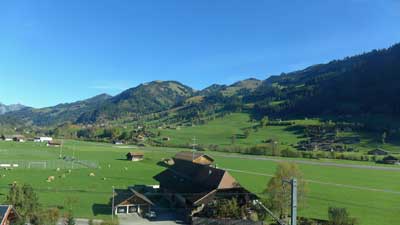
Geneva is a very famous city (though not for tourism reasons) on a lovely lake of the same name, but it’s also notoriously dull and lacking distinction. Rick Steves puts it well by saying that “Geneva is pleasantly situated on a lake, like Buffalo or Cleveland.” The point is, you don’t want to go to Geneva unless you’ve got something specific in mind that you want to see there.
Switzerland's cities in summary
Zurich – The largest city, very expensive, geared towards business travelers. It’s generally a pretty and very well-run city that you would enjoy if you visited, but it’s not nearly as interesting as the likes of Vienna, Munich, or of course Paris.
Geneva – Second largest city, in the French part of the country, no major sights. Again, if you visited you’d be very impressed by it and get some great photos, but it’s not worth your time unless you know someone there. There’s an impressive fountain in the lake and you can usually see it from the train as you go through the city, but it’s not really worth going there and staying more than an hour or so.
Basel – Bordering France and Germany, no major sights. It has the famous art market each year, and aside from that it’s even duller than the ones above. Again, if you visited you’d be impressed, but if you later compared photos with friends who went to the Lauterbrunnen Valley instead, you’d kick yourself for going to Basel.
Lausanne – Near Geneva in the French part of the country, very hilly, and certainly more interesting than Geneva.
Bern – The capital, compact, on a lovely river, some interesting sights and the best Swiss city to get a feel for the culture. Bern is fairly close to Interlaken (which we will discuss below) and it can be a great day trip from there, especially on a day where it is foggy and/or rainy in the mountains (and this happens a LOT).
How much time and which Swiss cities to visit?
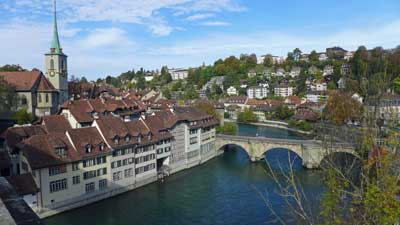
Many people (me included) don’t feel as if they’ve scratched the surface of a new country if they haven’t spent at least a day or two in the largest city. Zurich is certainly pleasant and a useful transit hub so spending one or two nights there wouldn’t be a major mistake. But Zurich isn’t even close to being a city like Paris, Rome, Berlin, Amsterdam, or even Vienna. If you skip it in favor of spending more time in the outdoors, you won’t be missing much.
The 2 Swiss places to focus on for short visits
Interlaken – If you want the best possible Alpine views and activities, head to the Interlaken area, which will be described in detail below.
Lucerne – The traditional Swiss tourist retreat, Lucerne is a small city with interesting culture and sights, that is gorgeously set on a lake with plenty of top activities surrounding it.
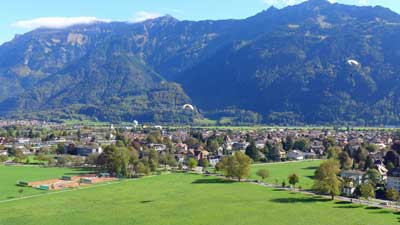
>>>Interlaken and Lucerne: Which to choose and how long to stay in each?
The article linked above will give you more details on which to choose and how long to spend in each place.
What about Zermatt for Alpine views?
Zermatt is a remote car-free village in southern Switzerland that is famous for being the place to see the Matterhorn mountain. It’s also a busy ski resort area, and aside from that, there isn’t much to see or do here. It’s on a private rail line, so it’s more complicated and usually more expensive to reach than Interlaken.
In other words, unless you’ve irrationally placed “Seeing the Matterhorn in person” on your so-called bucket list, skip Zermatt and head to Interlaken on a shorter visit. You won’t be sorry. If you already have enough time in your visit for the main sights around Interlaken and Lucerne and you want to also see the Matterhorn, then by all means go and you’ll enjoy it. There are quite a few other car-free villages in the Lauterbrunnen Valley near Interlaken, so they are not as novel in Switzerland as one might expect.
A weekend in Switzerland?
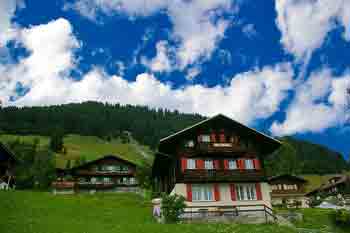
One challenge is that neither has an international airport so you’ll either be flying into Zurich or perhaps Geneva.
Train times from Zurich to Lucerne to Interlaken and back
- Zurich Airport to Lucerne: 1 hour 10 minutes by train
- Lucerne to Interlaken: 2 hours by train
- Interlaken to Zurich Airport: 2 hours 15 minutes by train
As you can see with the travel times above, Zurich Airport to Lucerne is a fairly short trip, but once you add Interlaken into the mix (even if you skip Lucerne) the travel time starts to add up for a weekend visit. With this in mind it’s probably best to just choose one of them and save the other one for another trip.
Lucerne is gorgeous, but the Lauterbrunnen Valley near Interlaken is really the star of the show, so I’d recommend going there first and doing Lucerne on another trip.
What about the Swiss Travel Pass?
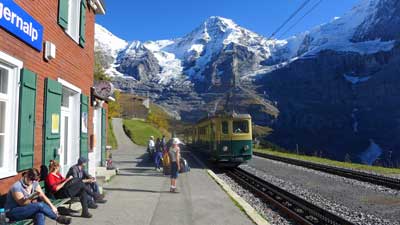
The bottom line is that if you are coming to Switzerland for at least 3 days and you want to take 2 or more of the amazing scenic rail journeys that the country is famous for, the travel pass is probably a good deal. It also provides 50% discounts on the Schilthorn cable car and 25% off the Jungfraujoch mountain railway. Both of those are quite expensive on their own, but extremely worthwhile, so the discount is helpful.
The Half Fare Card is probably a better deal for most people
The Swiss Travel Pass is a good deal for those who are going to be spending at least 2 or 3 days riding the rails and seeing Switzerland that way. But if you are mostly going to be focusing on Interlaken and Lucerne and the mountain sights, the Half Fare Card is the best option. For CHF120 (about US$134) you get the card that is good for 30 days and gives you a 50% discount on all trains, cable cars, mountain railways, and other sights and attractions. If you are doing either Schilthorn or Jungfraujoch, the Half Fare Card practically pays for itself with just one of those.
>>>Buy the Swiss Half Fare Card
Many people have questions about the Swiss Half Fare Card so I will explain it a bit here. You can actually buy half price train tickets for travel within Switzerland any time you want and you will see that option when you go to buy them online. The only thing is you have to have and present a valid Half Fare Card when you get on the train and are asked to see your ticket. In other words, you can buy a half fare train ticket today and buy a Half Fare Card just before you get on that train months in the future, and you are fine.
How and why visit the area around Interlaken
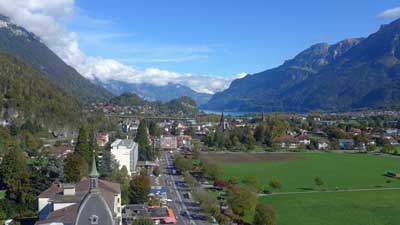
You can see everything discussed below by actually staying in a hotel in Interlaken, but it’s not the Alpine experience that you get if you stay in one of the small villages nearby. You can reach those villages in 20 to 40 minutes from the Interlaken Ost (East) train station, and it’s much easier than it sounds.
The 3 best places to stay to visit the Swiss Alps
Lauterbrunnen – A private train line runs from Interlaken Ost station to the end of its line in Lauterbrunnen. There’s a lovely waterfall here and great hiking trails, but you should probably only stay here if you can’t get to one of the villages mentioned just below. It’s a great little transit hub and it’s definitely gorgeous, so it can be worth a night if you’ve got one to spare.
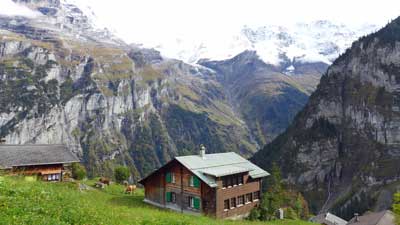
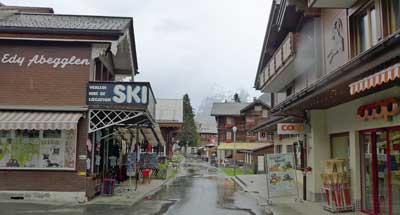
Where to stay in Interlaken and the Lauterbrunnen Valley (with pics)
I get so many questions about where to stay in the Interlaken area that I decided to write a longer version of it and load it with huge photos so readers can get a better feel for each option. I also included recommendations for affordable and well-located photos in each area.
>>>Where to stay in Interlaken and the Lauterbrunnen Valley New for 2024!
The unforgettable things to see here (if the weather is decent)
Schilthorn observation deck and restaurant
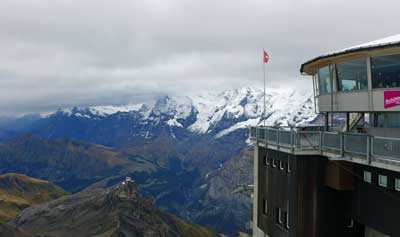
There is a rotating restaurant (with prices similar to normal Swiss restaurants) and a bizarre and anachronistic James Bond attraction based on it being a key location in the 1969 movie On Her Majesty’s Secret Service. The Bond thing is included with the lift, and it’s worth a look.
But the main thing you come here for is the 360-degree view from one of the highest peaks in Europe. Again, the weather here is key, but fortunately all the locals track the visibility on a minute-by-minute basis. If it’s clear up top while you are in the area, it would be a terrible shame to skip it based on the high price. But even if it’s cloudy up top, there are still plenty of wonderful things to see and do in the villages below.
Jungfraujoch observation area
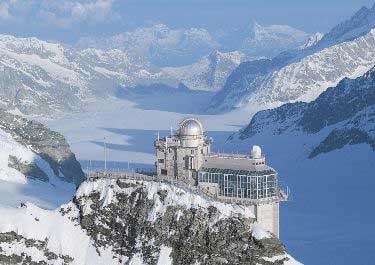
The views from the top are similar to the views from Schilthorn, from the other side of the Lauterbrunnen Valley. Once on top you can have lunch, hike, or even go sledding. It’s also quite expensive at nearly US$200 round-trip unless you have a Swiss Pass or a Eurail Pass for discounts, and it takes most of your day, but you’ll never forget the views from the top.
Harder Kulm mountain and Two Lakes Bridge Observation Deck
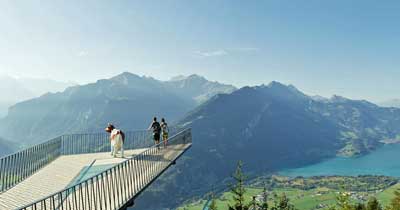
There’s a revolving restaurant about 10 minutes’ walk from the station at the top, which is definitely an unforgettable place for lunch if you’ve got time. It’s not as expensive as you might expect, at least compared to normal restaurants in Switzerland.
The Harder Kulm Railway goes from early April through late November each year. If you are only in Interlaken for one day and/or you are on a strict budget, this is the fastest and best way to get amazing Alpine views in the area.
Getting from Interlaken to Gimmelwald and Mürren
Getting up to these villages sounds complicated and time consuming, but it’s actually fast and easy once you get there. This little guide should help.
Arrive in Interlaken
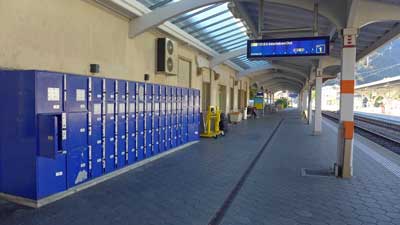
Once you arrive at the Interlaken Ost train station, head for the ticket windows in the office and buy a ticket to your final destination (Lauterbrunnen, Gimmelwald, or Mürren). Eurail passes are good for 25% discounts on the rest of the trip, but not for the whole thing.
From Interlaken Ost to Lauterbrunnen
The private train leaves Interlaken Ost every 30 minutes and arrives in Lauterbrunnen 20 minutes later. If you are staying in Lauterbrunnen then you are probably walking distance from your hotel when you reach the station.
From Lauterbrunnen to Gimmelwald
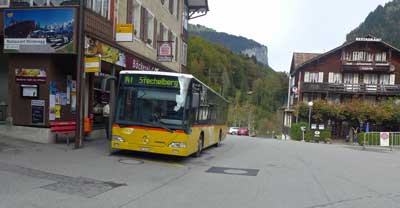
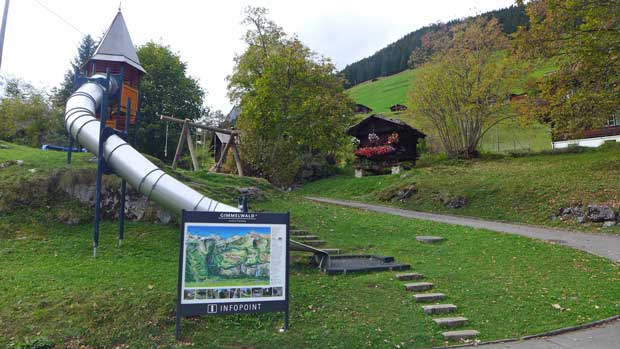
From
Gimmelwald to Mürren
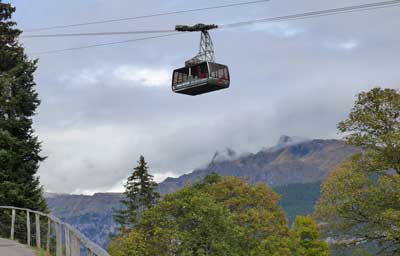
Recommended hotel and hostel in Gimmelwald
I get asked all the time about where to stay in Gimmelwald, so here it is:
Hotel: Esther’s Guesthouse
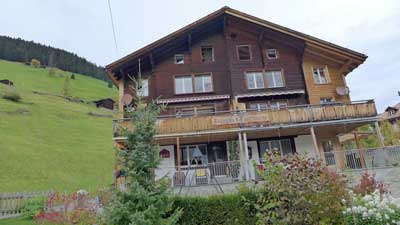
It’s run by Esther, as you might guess, and she is very friendly speaking excellent English. Each room is different and the place feels like a mountain cabin, because it is. She offers an excellent buffet breakfast in the morning, which you have to order the night before. It’s not cheap, but it’s worth it because it’s hearty and there are no other good options nearby.
Book as early as possible because this place is often the first place to sell out in Gimmelwald.
Hostel: Mountain Hostel Gimmelwald
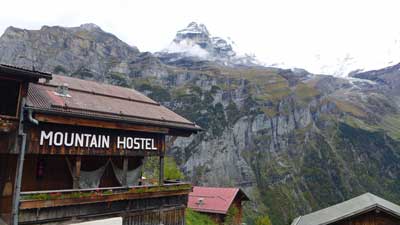
You won’t believe the views from this place, which are the same as from Esther’s except a bit lower and more unobstructed. This place also has a busy bar and restaurant that is basically the only “nightlife” in Gimmelwald. Many hikers get to bed early in this tiny village, but if you want to have a couple drinks and order a pizza or some local options, this is the place to go.
Again, book early because this place is always sold out.
Lucerne and what to do there
Luzern, as it’s spelled locally, is the other traditional holiday destination in Switzerland. Unlike Interlaken, Lucerne actually qualifies as a small city rather than a small resort town, so it’s a very nice contrast and very worthwhile.
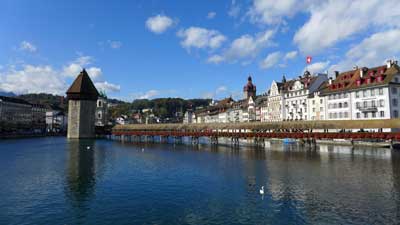
However, unlike Interlaken, the town of Lucerne itself is a great attraction and worth at least a day of exploration. This has always been a rich area so you can expect to find all of the high-end shops and boutiques along the small streets just north of the lake, but there are also many traditional shops and things to see that will appeal to anyone.
Recommended hotel in Lucerne
>>Hotel Des Alpes (3 stars with an amazing location and view)
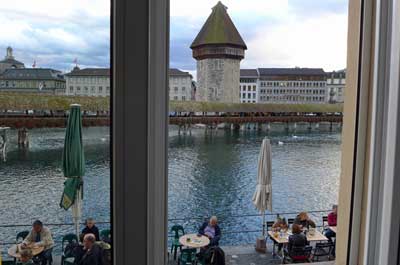
If this place is booked, which is often the case, then book a hotel as close to it as you can find or afford. The whole historic part of town surrounding it is lovely, with restaurants, bars, and high-end shops. There are also a couple of nearby supermarkets where you can buy inexpensive alcohol and picnic supplies to keep other costs down.
Spend a day in Lucerne itself
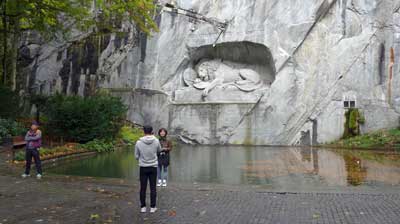
Most of the interesting part of Lucerne is in the area behind those restaurants, and it’s certainly worth doing a self-guided walking tour if not a guided one. Heading farther east you’ll come to another older part of town where the famous lion statue is located. You can’t visit Lucerne without having a look at the lion, and fortunately it’s easy and quick to reach (and it’s free).
Take a lake cruise of some kind
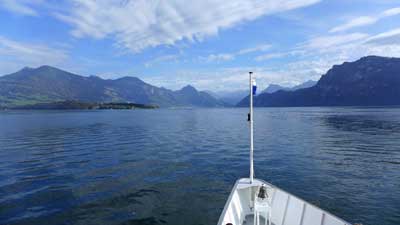
Especially in nice weather, even the short lake tour is lovely, and if you have more time you can jump off at Vitznau and do the scenic hike up Mount Rigi. There are also small lakeside villages that are ideal for a stroll and lunch stop. Long story short, there are dozens of interesting sightseeing options that are available using part of the boat tour, and the views all around are wonderful.
Visit Mount Pilatus
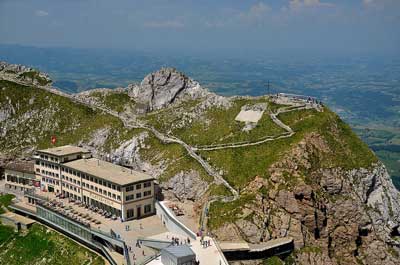
You can take the cogwheel train up and have a more or less flat hike around the summit area, and then take the gondola and cable car back down again. You can do them in the other order, and the cost is the same either way. At around US$65, this is not a cheap hike, but like most everything in Switzerland, the quality is high so it doesn’t feel like a rip-off. You can reach the cable car in 10 minutes on a public trolly bus from Lucerne.
Visit Mount Rigi
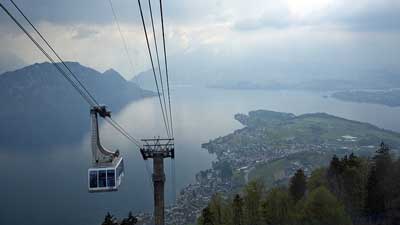
Unlike the other peaks mentioned in this article the Swiss Travel Pass covers both ways to get up and down for free. The others are 50% off with the Swiss Travel Pass or Half Fare Card, except for Jungfraujoch, which is only 25% off with the Swiss Travel Pass and still 50% off with the Half Fare Card.
Visit Mount Titlis
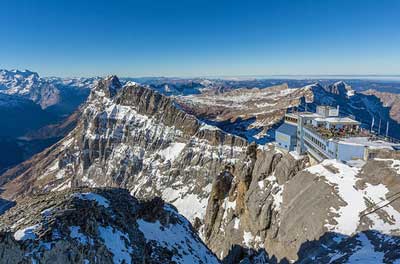
You can reach Titlis by taking a 43-minute train ride from Lucerne to Engelburg and then taking the cable car up from there. As with the others, it’s wise to check the weather immediately before you are going to depart because it can be foggy or cloudy any time of the year, but usually not for whole days at a time.
Additional photo credits
Jungfraujoch by cupweuro on Flickr, Pilatus by Tony Fernandez on Flickr, Rigi by Kosala Bandara on Flickr, Titlis by PaulSchliebs on Flickr

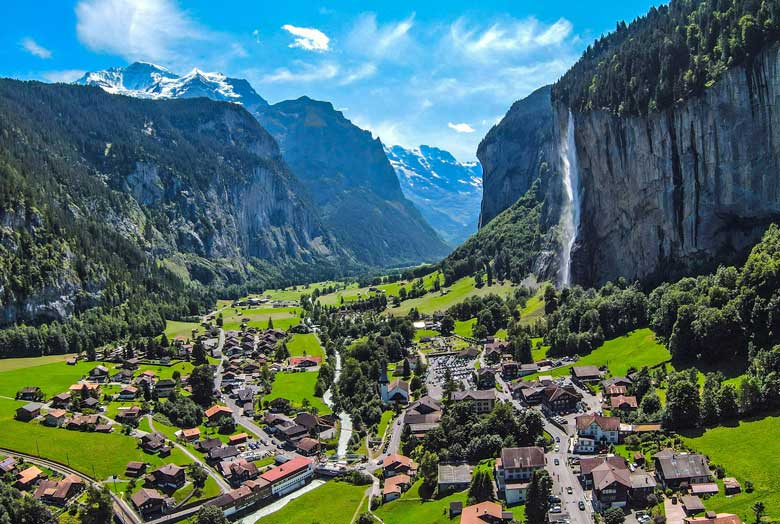
Roger, your article and the various responses to posts is most helpful. My husband and I are travelling to Basel in July to watch our daughter dance in the Tattoo. We will be based in Basel for 5 days and will then have another 4 days before flying out of Zurich. We had originally thought we would rent a car when we leave Basel and drive to a few places before returning the car at the Zurich airport (Interlaken and Lucerne sound perfect). But having read your posts I wonder if taking the train makes more sense. Can you let me know your thoughts on train vs. care. Also it sounds like a few day trips from Basel might be a good idea. Can you suggest any possible nearby sights?
Lisa,
Always glad to hear that this is helpful. Interestingly, my American brother lives in Germany, about 5 kilometers from Basel, so I’ve spent a lot of time in the area, although not too much in Basel itself. Unfortunately, it’s not one of the more charming parts of Switzerland, but that’s partly because the country has so many other highlights that aren’t really too far away.
First off, I definitely recommend the train over a car rental if your main goals are to visit Interlaken and Lucerne. The train fares are pretty reasonable, partly because the distances are not too long. One major problem with renting cars in Europe is that parking in cities is usually an expensive nightmare. In this case, Interlaken is kind of spread out and parking might not be tough, but Lucerne is more compact and you’d have to pay a fortune to park anywhere near a central hotel. Really, it’s so pleasant to hop off trains and walk to your hotel and to other sights, that driving would add a large layer of unnecessary stress.
Also, in Interlaken, you’ll probably want to stay in Gimmelwald or Murren to get the best experience, and those are both car-free cities so you’d have to park down below and take the cable car up. It’s better to just take the train to the bus to the cable car, as described in the article above, and not worry about a car.
All of that said, the area around Basel is nice enough and has many small vineyards, so spending a day or two looking around should be enjoyable. But really the highlights will be on your way to Interlaken and Lucerne. I hope this helps and feel free to follow up if you have other questions. -Roger
Thanks a lot Roger..
Hi Roger,
Great Articles about swiss tour…
I am Nakul from India.
Will be traveling to Swiss in the last week 22nd to 26th April 2016.
Actually we are travelling with Travel Company who will show us Mt. Titlis and Lucerne in one day on 22ndA April , after that we have deviation me , my wife will stay there for additional 3 days and board flight from zurich on 26th April 3 PM.
So I want to make most of these 3 days.
In evening of 22nd I would like to see lucerne night life.
After that spend 3 days as follows
1) 2 days in Interlaken
2) 1 day in zermatt
I have heard zermat is very beautifull.
Kindly guide us what we have planned is good or not.
we like to watch , visit mountains mainly snow capped mountains , area etc
will hostel be ok for couples ? or hotel is good.
Hotel is not issue as long as one night cost is less than 200$.
also will we get snow capped mountains/areas now in april ?
we are very keen on this aspect as we have never seen snow except in movies.
Thanks you
Nakul
Nakul,
I think your plan sounds really nice. One thing though, Zermatt is primarily a ski resort rather than a sightseeing city, except that it’s the place to go to see the Matterhorn. To reach Zermatt you have to take a normal Swiss train and then change to a private line for the last part, so it’s a bit remote and somewhat expensive. In other words, it may not be worth all the trouble to go for that one day to see the Matterhorn, and the Interlaken area is filled with stunning views of several main peaks. I think you’d be happy either way, although staying in or near Interlaken will be cheaper and easier.
The hostels in Switzerland cater to all age groups, so you should feel comfortable staying in one. You can get bunk beds in all of them, and many have private double rooms, although those usually aren’t any cheaper than hotels. In the Interlaken area, I highly recommend Esther’s Guesthouse or the Mountain Hostel in Gimmelwald. They are 50 meters from each other, just off the cable car stop in Gimmelwald. There is snow on the highest peaks all year round, and there will still be plenty of snow in April. If you are looking for the storybook Alpine experience then you’ll find it in Gimmelwald. I’ll bet that if you search for videos on Youtube for Gimmelwald, you’ll see at least a few that will show you what I mean.
If you also add Zermatt to your schedule then you won’t have much time to do more than walk a bit around town and admire the view of the Matterhorn. If you stay based in Gimmelwald or elsewhere in Interlaken, you’ll have more time for the top activities such as the Schilthorn or the train to Jungfraujoch. I’m sure you’ll have a great time and let me know if you have other questions. -Roger
Many thannks for Info Roger ,
I saw this video on zermatt
https://www.youtube.com/watch?v=Pr-zhRp_VQ8
I liked it very much , in this video apart from Mountains snow is in the city as well.
so basically I am looking for such place atleast for one day.
I am notn sure whether I will get that kindof scene in April ?
Ok…also we want to have some snow games to play , kindly suggest will interlaken have any snow games etc.
Also can we spend 3 days in Interlaken I mean to ask will interlaken have such much places to see for 3 days.
If we are staying in interlaken all those 3 days then is it worth to buy swiss rail pass.?
Thanks.
Nakul,
Yes, Zermatt is beautiful, especially from aircraft, although from many angles on the ground as well. But as the video says, it’s more of a ski resort area than a sightseeing area.
Interlaken definitely has plenty of things to keep you busy for more than 3 days. The town of Interlaken is actually between two large lakes, and they are all at the base of the Alps. It’s the primary sightseeing area in the Swiss Alps, with many visitors year round.
April is actually one of the better months of the year for snow. The highest peaks get snow all year, and the lower areas get snow mainly between November and March, so much of it will still be there in April. Not only are the Schilthorn and Jungfraujoch deservedly popular, but there are hiking trails all throughout the area, with many different types of views. There are ski lifts in many places in the area as well, including one or two in the town of Murren, which is just above Gimmelwald. You can walk between the two or take the cable car in 5 minutes. The ski lifts in Murren usually run until at least the middle of April, so there will be plenty of snow and snow activities.
If you are going to Zermatt and want to do several of the expensive cable cars and private trains then a Swiss Pass might make sense, but if you are going to focus on the Interlaken area then it’s unlikely you’d get enough use out of it. Still, it’s worth looking into. They have different variations that offer discounts or included admission to the expensive cable cars and all that, so if you want to do enough of them then it might pay off. Have a great trip. -Roger
Hi Roger.
I have never been to Switzerland and would like to go there with my wife for 3 nights (getting there 25/03/16 and leaving 28/03/16). I have read your detailed article but am still at a loss as we don’t have much time to spend there. Can you suggest which airport would be best to fly to from UK, where to have “base camp” in terms of accommodation so that we can see the “Interlaken” area. Also, is it easy to find places to eat for people with dietary needs (Kosher/Halal)? We too are on a “budget”, so I am asking a lot!
Cheers,
Naseer
Naseer,
Three nights will actually be enough time to get the amazing highlights of the Interlaken area, so I think you’ll be fine. You’ll want to fly into Zurich or perhaps Geneva, and then take trains directly from the airport to the Interlaken area. Both airports have train stations on the main routes, so it’s quite easy.
Once in the Interlaken area you have two main choices for a base camp. One would be in the town of Interlaken itself. It’s a scenic place and it’s also quite popular with Asian and Middle Eastern travelers, so you’d have no trouble finding Halal foods. If you stayed there you’d want to take the small train each of your two mornings to Lauterbrunnen and then up the mountain on the cable cars, as discussed in the article above. In addition to Schilthorn and Jungfraujoch, you probably want to hike from Gimmelwald up to Murren, or actually from Murren down to Gimmelwald is easier. Staying in Interlaken will mean it takes about an hour each way to get to the main attractions, but it’s all scenic and pleasant, so it’s probably your best bet.
The other main option would be to stay in Gimmelwald or Murren, which both give you unbelievably beautiful views right from your bed, and you are closer to the hikes and attractions. Gimmelwald is tiny so if the Halal thing is important then Murren would be the better choice. I don’t know for sure that Murren has Halal places, but I suspect that it does and you might want to Google that.
As far as being on a budget, you hopefully know that Switzerland is very expensive. Fortunately, it’s also a mind blowing place to see, so even if you splurge a bit it will feel like it’s worth it. You’ll probably want to choose Schilthorn OR Jungfraujoch rather than both of them because each is expensive. I recommend Schilthorn if the weather up there is decent. It’s expensive, but you’ll never see another view like that so it’s worth it.
Have a great trip and let me know if you have any other questions. -Roger
Hi Roger,
Thank you very much indeed for a very informative reply. Even if we don’t travel on the specified dates, we shall travel in the not too distant future and will make full use of your kind advice.
Thank you once again for your valuable time.
Naseer
Reading with great interest your article and comments. We are a family of 5 planning to fly into Paris and then driving thru Switzerland, Germany, Austria and Italy before flying on to Egypt and Israel. Our journey starts August 29. What road would be most scenic traveling the from Paris to Interlaken? I was thinking about staying a night in Geneva as i can stay free at Hilton but after reading your article, I might want to change. I was hoping to stay in Wengen for a night and then continue to Kyberg. Would you recommend getting accommodations ahead of time or use airbnb as we go? Any other ideas where to stay if not in Geneva?
Roy,
I haven’t done much driving in that part of Europe myself, although I’ve ridden a bit with my brother who lives in near Basel, Switzerland. Generally speaking, you’ll want to take the fastest highway in France or Switzerland. Fortunately, the views of the Alps and countryside will be really nice no matter the road you take. Once you get near the Alps you might take some smaller roads, though the best views will be once you take the cable car up the mountain and hike around where cars can’t go.
As mentioned in the article, Geneva is really kind of a dud of a tourist town, even though it’s so famous for being on a lake and being the headquarters of so many international companies and organizations. Also, parking there would be expensive and a hassle. I’d recommend just heading to Interlaken because it’s the best place for Alpine scenery and there are actually hotels there with free parking near the town center. The population density there is quite low, so driving around will be easy and pleasant, unlike driving through the large and crowded cities.
Wengen is essentially a suburb of Interlaken so it could be a good base if you can get a good hotel there. As mentioned in the article above, it’s really the Interlaken area that you want rather than the town itself. Wengen is closer to Lauterbrunnen, which is where you get the cable car to go up to Gimmelwald or Murren, which are the most scenic towns in the area.
I don’t know much about Kyburg, but if you have a reason to go there then I assume you’ll enjoy it.
I’ll definitely recommend booking accommodations ahead of time, assuming you are pretty confident of your itinerary. The end of August is obviously the beginning of shoulder season in Europe, but it’s still quite busy and the better places will all be booked in advance. Whether it’s hotels or airbnbs, I recommend booking as early as you are sure of your dates. In other words, if you lock in a schedule before you even get there, then booking ahead will give you the best availability and rates (last-minute discounts are extremely rare in Europe). For airbnbs in particular, I’d want to book at least a week ahead in order to have enough time to get approved and all that. Even if you don’t know of your exact dates until just a few days before, you’ll still want to book your accommodation at that point. There is really no benefit to booking at the last minute, or trying to book in person. Weirdly enough, pretty much all hotels in Europe offer better online rates than walk-in rates, even on arrival day.
So assuming you are going to just drive through Geneva or skip it altogether, I’d spend more time in Interlaken or perhaps in Lucerne if you have an extra two days or so. I hope this helps. Let me know if you have any other questions. -Roger
Hello!
Thank you so much for your posts, it has been helping me a lot to plan my trip to Switzerland!
My partner and I are traveling on a budget, but we want to enjoy the most that we can as we never know when we are going to have the chance of visiting Switzerland again. So I kind of have an itinerary in mind and would just like to know your opinion about it and how can we make the best of it. We will be in Switzerland from 6.30 am on the 30th of march to 5.30pm on the 3rd of April, arriving & departing from Zurich. Really short stay…
30th of March: Arrive in Zurich at 6.30 am. Catch a train and go to Lucerne. See the city and do mt Pilatus. Spent the night there.
31st: catch a train and go to Interlaken area and do the suggested trip above to Murren. We love hiking, so maybe sleep here and enjoy another half day here on the 1st of April.
1st April: after lunch go back to Interlaken and catch a train to Bern. Enjoy the city, spend the night.
2nd of April: Enjoy the city a bit more and after lunch time catch a train back to Zurich.
3rd of April: Enjoy Zurich and at 5.30pm fly out of Switzerland.
If you have something to add or any suggestions, please tell me! haha
Thank you again!
Larissa
Larissa,
I think your plan sounds really good and definitely well considered. Generally speaking, I’m more of a city person than a nature person, but Switzerland is one of the few places on earth where I really recommend people minimize time in cities and maximize time in the outdoors.
As I mention in the article, Bern is a very photogenic and pleasant city, and Zurich is also impressive in its own way. However, if you followed your plan exactly as written I think you’d regret only having those first two days in Lucerne and Interlaken. My best advice would be to add one more day in the Interlaken area, and push back your arrival in Bern. If you get to Bern at noon you can see all of the sights and town center by 5pm pretty easily. Then have dinner there and walk around a bit more.
The following morning you can take a train to Zurich to get there by 10am or 11am. Stow your bags at the train station and walk around the city center for a few hours before fetching your bags and heading to the airport for your flight. You’ll enjoy those hours in Zurich, and see that you haven’t really missed anything. Also, you’ll be glad you didn’t spend a night in a Zurich hotel, where even a very modest room starts at over US$200 per night. The city is built for business people on expense accounts, so it feels really overpriced to tourists. Bern is more reasonable, especially for hotels.
I hope this is the sort of advice you were looking for. Let me know if you have any other questions. -Roger
Hi Roger,
First of all, thank you for you article. It really full of useful information.
I am interested to go for both Gimmelward and Lucerne. Can you recommend an itinerary 5 days covering both places?
note: we will depart from Rome, Italy to Switzerland(Gimmelward and Lucerne), and then to Paris. appreciate if you could suggest a best & cheap route.
Ian,
Always happy to hear that this is useful. From Rome you’ll have to leave early. There is a train at 8am and another at 9am, but the 8am one is faster. That one gets to Milan at 10:55 and then you change to a different train to Spiez, Switzerland, arriving at 13:53. Then at 14:05 you board a train that gets you to Interlaken Ost at 14:28. Once you get there you’ll see a ticket counter where you can buy a ticket for the small train that takes you to Lauterbrunnen, and then the bus to the cable car stop, and then the cable car up to Gimmelwald, all in one ticket.
You’ll get to Gimmelwald at around 15:30 or so, which is just enough time to wander around the village and enjoy the stunning views. Buy the Rome to Interlaken Ost train ticket as soon as you can for the best price. The ticket from there to Gimmelwald is the same price no matter when you buy it, so just buy it when you get there.
You’ll want to spend most of the next day going up to Shilthorn and/or doing the Jungfraujoch train. You’ll also want to hike or take the cable car one more stop up to Murren for a wander through that town because it’s really nice and very different from Gimmelwald.
If it’s sunny (which isn’t always the case, even in summer) then you can probably see the main sights on that first full day, but I’d allow for another full day just in case. After 3 nights in Gimmelwald or perhaps 2 nights in Gimmelwald and one down in Interlaken itself, you can get the train to Lucerne, which takes 1 hour 50 minutes, and is the same price no matter when you buy it. So you can buy it in advance, or when you get there.
Then spend two days in Lucerne. As long as the weather is decent, the main attraction in Lucerne is a cruise on the lake to the other nearby small towns. You can stay on and go straight back to Lucerne, or hop off and go up the mountains or see other attractions before getting a later boat back to Lucerne. And the town itself is really gorgeous and pleasant. You’ll have plenty to keep you busy for two days there. Let me know if you have any other questions. -Roger
Hi Roger!
Excellent information about Switzerland 🙂 I am planning to go this summer with some relatives – we’d be 8, and we were thinking of renting a car to spend 7-8 days visiting the country. I was therefore wondering where it would be better to stay. Interlaken sounds interesting and it’s more or less in the middle of the country, but I was wondering if it would be better to stay in two different places during those 7-8 days in order to cover a wider area. I was thinking of doing 1-day trips to Geneva, Zurich, Bern, Luzern, and Basel, so as we are 8, it would be more convenient to stay in a rented house and try to find a central place to move around. Do you think this is a good idea? Is Interlaken a good place to stay? Thanks very much!
Beatriz,
This sounds like a really fun trip. Not only would Interlaken be a central place to launch those day trips, but it’s the only place on your list where parking will likely be free or easy. It’s a relatively spread-out town and many of the hotels there (and probably all of the rental houses) have free parking or parking lots. In those cities, including Lucerne, you’d have to find a garage or pay lot and probably pay at least US$20 or more for a partial day or overnight.
So Interlaken is good for a few days itself and also as a base for some road trips, but you might also consider spending at least a couple days in the Lucerne area because it’s very different and also wonderful.
I mention near the top of the article above that Switzerland’s cities are actually pretty boring compared to Europe’s great cities and especially compared to the outdoor scenery and activities. And as I mention, Bern is the most charming and worthwhile to spend a day or so in. Geneva has little to see aside from the lake it overlooks, and Basel doesn’t even have a lakeside setting. Zurich might be worth a bit of a look, but it’s unbelievably expensive and you’ll wish you spent another day in the countryside instead.
My general theory on cities like this is that if you have specific things you want to see in one or more of those cities, then maybe it’s worth a visit. But otherwise I’d just spend a day in Bern and maybe see the others driving by. You could do a drive to the Appenzell region, which is a traditional dairy area, and maybe even into Liechtenstein for a few hours.
Again, Switzerland in general is quite expensive compared to the rest of Europe, so it’s important to plan well. With a group of 8 I do think a rental house for most or all of your 7 or 8 days will be the best value and also most enjoyable. With a house you’ll have the ability to do some of your own cooking, which means you won’t have to find a house close to the main restaurant areas. The Interlaken area is pretty big, and fairly spread out, so you could find a house in almost any part of it and be fine as long as it has car parking. Best of luck with all of this, and feel free to ask more questions if you have them. -Roger
Hello,
thank you so much for all the helpful information. I am planning a 2.5-day trip in Lucerne and Interlaken. We arrive in Zurich in the late evening and plan to go straight to Lucerne, stay there 2 nights, move to Interlaken, go up to Schilthorn and stay the night at Gimmelwald, and hike some more the next day. Should we spend just a half-day at Lucerne and stay 2 nights at Gimmelwald? Do you recommend we visit both Jungfraujoch and Schilthorn? thank you in advance.
Yoon,
This is a bit of a tough question because the answer has a lot to do with your goals and preferences. Lucerne is a really pleasant and photogenic town on a nice lake. Personally, the lake itself isn’t too special and it’s really a place that many people just go to relax. Also, I’ve been on a lot of lakes, including many that are just as scenic.
Interlaken, on the other hand, is like nowhere else on earth. As long as the weather is mostly clear then you won’t believe the scenery that is surrounding you. Even if it’s overcast or foggy (which it often is), then it’s still an amazing place unlike anything you’ve seen. The Schilthorn observation deck is among the most amazing places I’ve ever been, and I’ve been all over the world. And as I mention above, the tiny (and I do mean tiny) village of Gimmelwald feels like you are on a movie set, except it’s all very real. Even the larger town just above of Murren is gorgeous, with plenty more options.
So it’s pretty obvious what I would do, which is spend most of the time in the Interlaken area. But if you’ve seen more dramatic mountains than lakes, Lucerne might be more appealing. Honestly, Lucerne is very nice and you should spend most of a day there if you can, but Interlaken is otherworldly.
As for Schilthorn vs Jungfraujoch, you just might want to wait until you get there to decide. You can check various web cams during the day and see what the conditions are in both areas. If both are clear I’d head up Schilthorn right away. It takes less than an hour to get to the top, and once up there you can have lunch and see everything (including the James Bond exhibit) in about an hour, so it’s only a 3-hour activity. The Jungfraujoch railway, from what I hear, takes most of a day going up and coming back down, and it’s cold in the carriages. If it’s clear and you have time to do both, then go for it. If you are thinking about both you might also look into one of the Swiss Passes that include the fares or give discounts. Have a great trip with whatever you decide. -Roger
Hi,
I am planning a 3 day Switzerland trip and I mainly want to see natural beauty, snowy mountains, and beautiful lakes. I’m flying from Amsterdam. Which city should I go to? Thank you, your article has been of immense help.
Khizer,
You should be able to find a pretty cheap flight into Zurich, and that airport is less than two hours by train from both Interlaken and Lucerne. Better still, the train rides between all of these places are all pretty stunning as well.
So fly into Zurich and then head to Interlaken and follow the instructions mentioned above for the best views and experiences. I’d allow two nights there and then one night in Lucerne for the lake cruise and different views.
Let me know if you have any other questions. -Roger